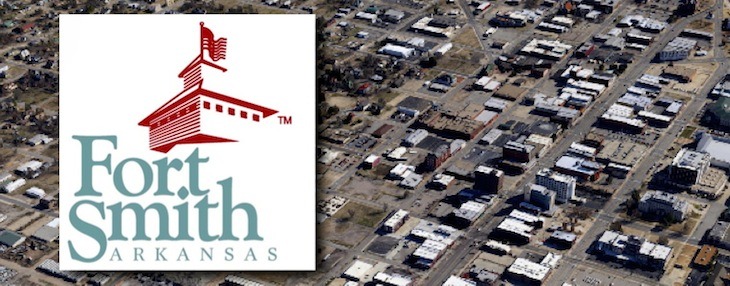Fort Smith officials talk about need, funding for more sidewalks
by February 19, 2020 4:43 pm 1,033 views

Though the Fort Smith Streets and Traffic Control department does not construct new sidewalks in the city, it does average about five miles of sidewalk repair each year.
Matt Meeker, director of the streets department, told the Fort Smith Board of directors at the Feb. 11 study session that since 2013, about 28 miles of Fort Smith sidewalks have been repaired, noting that sidewalk repair work was hampered in 2019 because of the record flooding and tornado damage in May and other damaging storm events that caused repair work to be shifted to other areas.
The street department spends about $900,000 annually, money it receives from state turnback funding from the ½-cent highway sales tax the city began receiving in 2013, on sidewalk repair, Meeker said. The funding allowed the city to add two dedicated sidewalk crews and supply them with the necessary trucks, trailers and equipment, he said.
“With the exception of completing short gaps between existing sidewalks, the (streets department) is not constructing any new sidewalks,” Meeker said. “The department just doesn’t have the staff or the funding to for new sidewalk projects.”
Most of the request for new sidewalks receives are “of a size and complexity that would well exceed our available construction budget,” he said, noting these are projects that would require combinations of surveys, right-of-way acquisitions, major utility relocation, drainage systems or road widening.
“Projects of this magnitude would require a consulting engineer to design the project, and work would need to be bid out to a private contractor,” Meeker said. “We don’t have the budget for that.”
Meeker added that he did not disagree with any of the requests to add sidewalks, noting that many of the requested projects are needed. He said there simply wasn’t funding for them. Director Robyn Dawson said it was “amazing” to her that a city the size of Fort Smith does not put in “any sidewalks” and asked what the city could do to address the need for more sidewalks.
“The funding would have to come from somewhere if you want to relocate funds,” Meeker said.
Meeker did note that when the city undertakes large master street plan projects, like the widening of Jenny Lind Road and North 50th Street, sidewalks are included in the project.
City Administrator Carl Geffken and other directors noted that while the city does not build sidewalks, many developers install them in new developments being built in the city, especially in Chaffee Crossing, as part of the development plan. Developers have the choice of putting in sidewalks in any new development or paying a fee to the sidewalk program, said Maggie Rice, director of the Department of Development Services.
“Out at Chaffee Crossing, especially in the residential areas, they do install sidewalks. So those neighborhoods going in will have sidewalks,” Rice said. “So there is a connectivity, and the new developments are installing sidewalks.”
Even so, city directors said they hoped more could be done for city sidewalks.
“This is a problem in the city of Fort Smith, and I would like to see some way we could get it addressed,” said Director Neal Martin.
City Director Lavon Morton said perhaps some money received from FEMA due to the flooding in 2019 could be used for some one-time sidewalk projects.
“In a couple of months, we should have a good read on how the year 2019 looks as far as revenues and expenditures,” Morton said. “I am hopeful. I tend to be an optimist. If we see we have some money that we can dedicated to specific projects. … In areas where there is great need for sidewalks, we could look at allocating some funds for that.”
Director Andre Good emailed Geffken and Mayor George McGill in October about the need for a sidewalks in the area of North 32nd Street between North O Street and Gand Avenue.
“This section of street is highly traveled by pedestrians, cyclists and wheelchair-bound citizens. We desperately need the roadway widened and sidewalks the length of this corridor. I have asked for years, and now it’s simply time to budget for it, get assistance if needed and get this done,” Good said in the email.
He addressed the issue again during the study session, noting is the area where Charlotte Tidwell’s Antioch food pantry will be. The new pantry is at 1420 N. 32nd St.
“This operation will increase the amount of auto traffic as well as foot traffic. More cars increase the risk to pedestrians, thus the increased need for sidewalks,” Good said.
He noted that about 120 pedestrians, either on foot, wheelchairs, bicycles or scooters use North 32nd Street as their route from low-income housing to grocery stores, banking, Salvation Army and thrift markets on Grand Avenue.
“As a major collector street, North 32nd Street is heavily traveled by car, pickup, truck, light and heavy commercial vehicles. The street is lined with deep grassy culverts on both sides. Mid-distance, the street falls within a 50 year flood zone. A low water bridge has existing sidewalks rendered useless by the culverts they drop into. This is a crisis waiting to happen. Interviewed pedestrians tell of being forced into the roadside ditches and actually hit by passing motorists, making this a high priority project,” Good said in his email.
